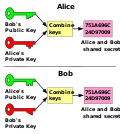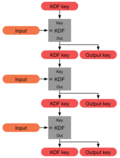Authenticated Key Exchange (AKE), Authenticated Key Agreement (AKA) or Authentication and Key Establishment (AKE) is the exchange or creation of a session...
2 KB (236 words) - 21:38, 11 February 2025
Password-authenticated key agreement generally encompasses methods such as: Balanced password-authenticated key exchange Augmented password-authenticated key exchange...
17 KB (1,799 words) - 23:21, 29 December 2024
the keys at the time of authentication. The simplest solution for this kind of problem is for the two concerned users to communicate and exchange keys. However...
4 KB (584 words) - 20:34, 18 October 2024
SPEKE (redirect from Simple Password Exponential Key Exchange)
Exponential Key Exchange) is a cryptographic method for password-authenticated key agreement. The protocol consists of little more than a Diffie–Hellman key exchange...
7 KB (1,005 words) - 19:54, 26 August 2023
The Password Authenticated Key Exchange by Juggling (or J-PAKE) is a password-authenticated key agreement protocol, proposed by Feng Hao and Peter Ryan...
10 KB (1,501 words) - 14:33, 2 April 2025
HMAC (redirect from Keyed-Hashing Message Authentication)
expanded as either keyed-hash message authentication code or hash-based message authentication code) is a specific type of message authentication code (MAC) involving...
18 KB (2,316 words) - 18:51, 16 April 2025
Key exchange (also key establishment) is a method in cryptography by which cryptographic keys are exchanged between two parties, allowing use of a cryptographic...
12 KB (1,397 words) - 19:44, 24 March 2025
functions as cryptographic primitives. It is related to symmetric authenticated key exchange. SKA may assume the use of initial shared secrets or a trusted...
12 KB (1,470 words) - 17:20, 14 January 2025
Encrypted Key Exchange (also known as EKE) is a family of password-authenticated key agreement methods described by Steven M. Bellovin and Michael Merritt...
3 KB (389 words) - 16:17, 17 July 2022
password-authenticated key exchange or PAKE. In basic authentication, the server learns the user's password during the course of the authentication. If the...
28 KB (3,402 words) - 09:41, 22 April 2025
of authenticated encryption modes. In 2015, ChaCha20-Poly1305 is added as an alternative AE construction to GCM in IETF protocols. Authenticated encryption...
19 KB (2,104 words) - 09:27, 17 May 2025
shown in 1969 how public-key cryptography could be achieved. Although Diffie–Hellman key exchange itself is a non-authenticated key-agreement protocol, it...
48 KB (5,437 words) - 16:48, 22 April 2025
cryptography, Simultaneous Authentication of Equals (SAE) is a password-based authentication and password-authenticated key agreement method. SAE is a...
6 KB (631 words) - 23:13, 2 April 2025
a password-authenticated key agreement protocol that ensures mutual authentication of two parties by using a Diffie–Hellman key exchange to establish...
3 KB (230 words) - 01:38, 26 April 2024
above is an authenticated version in the work of Zhang, Zhang, Ding, Snook and Dagdelen in their paper, "Post Quantum Authenticated Key Exchange from Ideal...
23 KB (3,424 words) - 23:09, 30 August 2024
Zero-knowledge password proof (category Password authentication)
P1363.2, in reference to one of the benefits of using a password-authenticated key exchange (PAKE) protocol that is secure against off-line dictionary attacks...
3 KB (331 words) - 14:44, 1 July 2022
keyed hash, message authentication code, or protected checksum. Informally, a message authentication code system consists of three algorithms: A key generation...
16 KB (1,918 words) - 17:55, 22 January 2025
Secure Remote Password protocol (category Key-agreement protocols)
Secure Remote Password protocol (SRP) is an augmented password-authenticated key exchange (PAKE) protocol, specifically designed to work around existing...
28 KB (3,404 words) - 16:06, 8 December 2024
Internet Key Exchange v. 2 (EAP-IKEv2) is an EAP method based on the Internet Key Exchange protocol version 2 (IKEv2). It provides mutual authentication and...
34 KB (4,172 words) - 20:50, 1 May 2025
Forward secrecy (redirect from Non-interactive key exchange)
Oorschot, Paul C.; Wiener, Michael J. (June 1992). "Authentication and Authenticated Key Exchanges" (PDF). Designs, Codes and Cryptography. 2 (2): 107–125...
26 KB (3,047 words) - 02:37, 21 May 2025
protocol for password-based authenticated key exchange. He has also worked in the areas of secure multi-party computation, public-key encryption, and digital...
9 KB (925 words) - 20:37, 15 January 2025
Pake may refer to: Password-authenticated key exchange (PAKE) Pākē, Hawaiian language term for Chinese in Hawaii Pake, California Páké, alternative name...
375 bytes (69 words) - 06:31, 30 September 2024
One-time password (redirect from One-time key)
algorithm Two-factor authentication Paterson, Kenneth G.; Stebila, Douglas (2010). "One-Time-Password-Authenticated Key Exchange" (PDF). In Steinfeld...
26 KB (3,542 words) - 07:02, 15 May 2025
IPsec (redirect from Authentication Header)
Association and Key Management Protocol (ISAKMP) provides a framework for authentication and key exchange, with actual authenticated keying material provided...
44 KB (5,337 words) - 03:03, 15 May 2025
Post-quantum cryptography (section Lattice-based cryptography – LWE key exchange and Ring-LWE key exchange)
6956-bit public keys for the Peikert's scheme. The corresponding private key would be roughly 14,000 bits. In 2015, an authenticated key exchange with provable...
63 KB (6,408 words) - 13:56, 6 May 2025
password-authenticated key exchange. There are two classes of TLS-SRP ciphersuites: The first class of cipher suites uses only SRP authentication. The second...
3 KB (339 words) - 17:03, 25 June 2021
framework for authentication and key exchange and is designed to be key exchange independent; protocols such as Internet Key Exchange (IKE) and Kerberized...
5 KB (572 words) - 23:14, 5 March 2025
automatically authenticated. In systems such as X.509-based PKI, fingerprints are primarily used to authenticate root keys. These root keys issue certificates...
9 KB (1,286 words) - 03:43, 19 January 2025
peers. SSB peers exchange asymmetric keys and establish authenticated connections between each other using an Authenticated Key Exchange protocol, Secret...
12 KB (967 words) - 15:48, 6 May 2025
digital cash, password-authenticated key agreement, time-stamping services and non-repudiation protocols. Because asymmetric key algorithms are nearly...
40 KB (4,512 words) - 17:51, 26 March 2025








